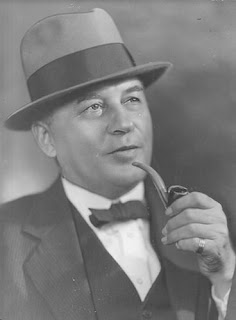By T.S. Akers
Bohumil Makovsky
Freemasons are
directed to study the Liberal Arts and Sciences in the Fellowcraft degree.
Masonic teachings tell us that those include grammar,
rhetoric, logic, arithmetic, geometry, music, and astronomy.
In Oklahoma, one Brother was particularly
adept at music.
Born in Frantisky
Bohemia, on September 23, 1878, Bohumil “Boh” Makovsky arrived in the United
States at age seventeen.
[i] He made his way to Nebraska to join his
Sister’s family where he took an apprenticeship with a cigar maker.
Unable to speak English, Makovsky was skilled
with his Albert System Clarinet.
[ii] It was Makovsky’s Uncle who taught him to play
the clarinet, as Makovsky had little formal education.
[iii]
An accomplished
musician, Makovsky soon began leading a band in Nebraska. It was in 1903 that his band was booked to
play in Davis, Oklahoma Territory. Upon
arrival, the band learned there was no gig, so Makovsky paid the band members
and made his way to Oklahoma City. There
he gave music lessons and played the State Fair on a regular basis. Oklahoma also happened to be home to an
Eastern European community, which allowed for Makovsky to lead polka bands in
Woodward, Yukon, and Prague.[iv]
Makovsky
settled in Woodward in time and there found himself knocking on the doors of
Freemasonry. On May 21, 1908, he was
initiated an Entered Apprentice in Woodward Lodge No. 189 AF&AM. Makovsky would then be passed to the degree
of Fellowcraft on July 2 and raised to the degree of Master Mason on August 6.[v] During the Reunion of October 6-8, 1908, at
Guthrie, he took the degrees of the Scottish Rite of Freemasonry.[vi] It was by becoming a Masonic ritualist and
committing large portions of degree work to memory that Makovsky was able to
master the English language.[vii]
In 1915,
Makovsky was asked to become the Band Director at Oklahoma A&M (now
Oklahoma State University). With that
title, he also became the Director of Music.[viii] Makovsky then made his home in Stillwater,
affiliating with Frontier Lodge No. 48 AF&AM in 1918; he was
Worshipful Master of the lodge in 1922.[ix] Makovsky would serve at Oklahoma A&M until
1943.[x] A bit eccentric, one colleague described
Makovsky as the most unforgettable characters he had ever known. For example, Makovsky liked to refer to rare
instruments owned by the school as “his pets.”[xi]
Makovsky in his Oklahoma A&M band uniform, c. 1923
An active
Scottish Rite Mason, Makovsky long served as Organist at the Guthrie
Temple.
He was elected a Knight
Commander of the Court of Honor in 1921 and coroneted a 33
rd Degree
in 1927.
[xii] Makovsky was also a York Rite Mason and served
as Commander of St. John’s Commandery No. 8, Knights Templar, stationed at
Stillwater, in 1928. He additionally served as High Priest of Stillwater Chapter No. 14, Royal Arch Masons in 1921. Makovsky was the first Illustrious Master of Stillwater Council No. 50, Royal and Select Masters in 1949.
Makovsky's Knight Templar Sword
(From the collections of the McAlester Scottish Rite Temple)
Makovsky
earned numerous honors throughout his lifetime.
He received an Honorary Doctorate from the University of Tulsa and was
the first honorary member of Kappa Kappa Psi, a music fraternity. Kappa Kappa Psi would come to call Makovsky
their “Guiding Spirit.” He was also
bestowed the title of “The Great Father of Oklahoma Music” by the Kiowa Tribe.[xiii] Makovsky would be inducted into the Oklahoma
Hall of Fame in 1938.[xiv] His trademark crushed velvet bowtie and
saxophone shaped pipe were long remembered in Stillwater[xv]. Makovsky died on June 12, 1950, and was laid
to rest in Fairlawn Cemetery of Cushing, Oklahoma.[xvi]
[i] “Facts About Boh,” Kappa Kappa Psi Alpha Chapter, accessed July 21, 2015, http://www.okstate.edu/osu_orgs/kkp/Boh.html.
[ii] “Bohumil Makovsky,” Kappa Kappa Psi Alpha Chapter, accessed July 21, 2015, http://www.orgs.okstate.edu/kkp/boh.html.
[v] “Makovsky, Bohumil” (member profile, Most
Worshipful Grand Lodge of the State of Oklahoma AF&AM).
[vi] “Makovsky, Bohumil” (member profile, Guthrie Valley
of the Ancient and Accepted Scottish Rite).
[vii] “Bohumil Makovsky.”
[ix] “Makovsky, Bohumil” (member profile, Most
Worshipful Grand Lodge of the State of Oklahoma AF&AM).
[xii] “Makovsky, Bohumil” (member profile, Guthrie
Valley of the Ancient and Accepted Scottish Rite).
[xiii] “Facts About Boh.”
[xiv] “Inductees,” Oklahoma Hall of Fame, accessed July 21, 2015, http://www.oklahomahof.com/Inductees/SearchbyDate.aspx.
[xvi] “Bohumil Makovsky,” Find A Grave, accessed July 21, 2015, http://www.findagrave.com/cgi-bin/fg.cgi?page=gr&GRid=7210498.





